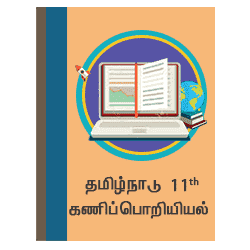
11th Standard Syllabus & Materials
11th Standard
TN 11ஆம் வகுப்பு உயிரியல் தாவரவியல் - வகைப்பாட்டியல் மற்றும் குழுமப் பரிணாம வகைப்பாட்டியல்முக்கியமான 2,3,&5 மதிப்பெண் வினாக்கள் விடைகளுடன் TN 11th Biology Bio - Botany - Taxonomy and Systematic Botany 2,3,&5 Marks Questions with Answers.
11th Standard
TN 11ஆம் வகுப்பு உயிரியல் தாவரவியல் - தாவர உலகம் முக்கியமான 2,3,&5 மதிப்பெண் வினாக்கள் விடைகளுடன் TN 11th Biology Bio - Botany - Plant Kingdom 2,3,&5 Marks Questions with Answers.
11th Standard
TN 11ஆம் வகுப்பு உயிரியல் விலங்கியல் - வேதிய ஒருங்கிணைப்பு முக்கியமான 2,3,&5 மதிப்பெண் வினாக்கள் விடைகளுடன் TN 11th Biology Bio - Zoology - Chemical Coordination and Integration 2,3,&5 Marks Questions with Answers.
11th Standard
TN 11ஆம் வகுப்பு உயிரியல் விலங்கியல் - விலங்குலகம் முக்கியமான 2,3,&5 மதிப்பெண் வினாக்கள் விடைகளுடன் TN 11th Biology Bio - Zoology - Kingdom Animalia 2,3,&5 Marks Questions with Answers.
11th Standard
TN 11ஆம் வகுப்பு உயிரியல் விலங்கியல் - விலங்குகளின் உறுப்பு மற்றும் உறுப்பு மண்டலங்கள் முக்கியமான 2,3,&5 மதிப்பெண் வினாக்கள் விடைகளுடன் TN 11th Biology Bio - Zoology - Organ and Organ Systems in Animals 2,3,&5 Marks Questions with Answers.
11th Standard
TN 11ஆம் வகுப்பு உயிரியல் விலங்கியல் - நரம்பு கட்டுப்பாடு மற்றும் ஒருங்கிணைப்பு முக்கியமான 2,3,&5 மதிப்பெண் வினாக்கள் விடைகளுடன் TN 11th Biology Bio - Zoology - Neural Control and Coordination2,3,&5 Marks Questions with Answers.
11th Standard
TN 11ஆம் வகுப்பு உயிரியல் விலங்கியல் - வணிக விலங்கியலின் போக்குகள் முக்கியமான 2,3,&5 மதிப்பெண் வினாக்கள் விடைகளுடன் TN 11th Biology Bio - Zoology - Trends in Economic Zoology2,3,&5 Marks Questions with Answers.
11th Standard
TN 11ஆம் வகுப்பு உயிரியல் விலங்கியல் - திசு அளவிலான கட்டமைப்புமுக்கியமான 2,3,&5 மதிப்பெண் வினாக்கள் விடைகளுடன் TN 11th Biology Bio - Zoology - Tissue Level of Organisation System 2,3,&5 Marks Questions with Answers.
11th Standard
TN 11ஆம் வகுப்பு உயிரியல் தாவரவியல் - சுவாசித்தல் முக்கியமான 2,3,&5 மதிப்பெண் வினாக்கள் விடைகளுடன் TN 11th Biology Bio - Botany - RespirationSystem 2,3,&5 Marks Questions with Answers.
11th Standard
TN 11ஆம் வகுப்பு உயிரியல் விலங்கியல் - உயிருலகம் முக்கியமான 2,3,&5 மதிப்பெண் வினாக்கள் விடைகளுடன் TN 11th Biology Bio - Zoology - The Living World System 2,3,&5 Marks Questions with Answers.

Published on: 29/11/2018
This is the half-yearly model question for 11th accountancy.
This is the unique half yearly model question for 11th accountancy. This question paper is prepared with selective questions in public pattern based on the state board half yearly syllabus.
Important questions from the chapters such as Introduction To Accounting, Conceptual Framework Of Accounting, Books Of Prime Entry, Ledgers, Trial Balance, Subsidiary Book, Bank Reconciliation Statement, Rectification Of Errors, Capital And Revenue Transactions, Depreciation Accounting are included.
By practicing with this important model question paper student can gain more knowledge and confidence to crack the exams. This question paper is designed based on the academic syllabus. It will be more helpful for the Matriculation and state board students to prepare for their exams.
Questions from most important topics are covered in this question paper. This is the most important question paper for Plus One students for the subject Accountancy. By practicing repeatedly you will get the idea of answering the questions and this improves the speed of answering.
Tamilnadu Stateboard 11th Standard Subjects

Maths

Commerce

Economics

Biology

Business Maths and Statistics

Accountancy

Computer Science

Physics

Chemistry

Maths

Biology

Economics

Physics

Chemistry

History

Business Maths and Statistics

Computer Science

Accountancy

Computer Applications

History

Computer Technology

Commerce

Computer Applications

Computer Technology

Tamil

English

French
Tamilnadu Stateboard Standards